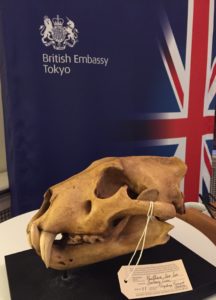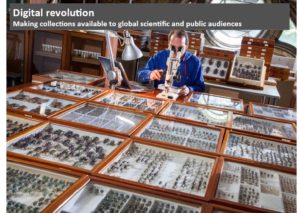29th March 2017 Tokyo
Behind the scenes at the museum: treasures from the natural world draw the crowds in Japan
A visit to one of London’s museums, with free entrance to the public, is one of the highlights of a trip to the capital for many tourists. For the Natural History Museum, a world-famous attraction, foreign visitors now make up around 60% of the five million people enjoying its galleries, exhibitions, events and education programmes every year.
On a sunny weekend in Tokyo, with the first buds of cherry blossom starting to open, the public queued around the block to see the first ever Japanese exhibition of treasures from the Natural History Museum. Sponsored by Yomiuri Shimbun, the National Museum of Nature and Science is hosting beautiful and important specimens such as archaeopteryx, a first edition of Darwin’s origin of the species, William Smith’s first geological map of Britain and even an extinct species of Japanese sea lion from the Voyage of the Challenger, which docked in Yokohama in 1875. Computer generated images captured the imagination of young and old, showing how the fossils would have looked as living, breathing creatures, flying and hunting around a virtual Natural History Museum.

The Natural History Museum is also a world leading scientific research centre. The breadth and depth of the Museum Collection makes it the most important of its kind in the world: 80 million plants, animals, fossils, rocks and minerals spanning 4.6 billion years of history.
Professor Ian Owens, the Museum’s Director of Science, gave a lecture on 17 March at the British Embassy Tokyo to an audience of Japanese government, industry and academia to explain how the Museum has been using its collection to build the scientific understanding of the natural world for more than 250 years. Behind-the-scenes more than 350 scientists and students are using the collection for research into some of the biggest challenges facing our species, such as eliminating parasitic diseases that condemn millions to poverty, finding new sources of minerals and measuring the impact of climate change. Collaboration with research institutes around the world helps to build common understanding of the world around us and how to protect it.

Technologies such as high capacity genomic analysis are revealing new information about species and their environments. Sequencing of mitochondrial genomes from an afternoon of beetle-catching in Borneo revealed more than 100 new species. The museum is also using the power of citizen science to help digitise the collection and make valuable specimens available to researchers around the world. So if you can’t make it over to Tokyo this spring to see the exhibition, why not log on to data.nhm.ac.uk to explore the collection for yourself.
